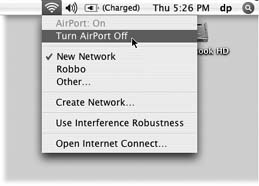19.5. Switching Locations
| < Day Day Up > |
19.4. AirPort NetworksAirPort is Apple's term for the 802.11 (WiFi) wireless networking technology. If you have it, you'll remember having paid $80 or $100 for an AirPort card, which lets any modern Mac model communicate with an AirPort base station up to 300 feet away, much like a cordless phone. Doing so lets you surf the Web from your laptop in the TV room, for example, or share files with someone across the building from you. (Details on Section 13.1.1.) Most people set up an AirPort base station in one of three ways:
For the easiest AirPort network setup, begin by configuring your Mac so that it can go online the wired way, as described on the previous pages. Once it's capable of connecting to the Internet via wires, you can then use the Airport Setup Assistant (in your Applications Utilities folder) to transmit those Internet settings wirelessly to the base station itself. From then on, the base station's modem or Ethernet jack ”not your Mac's ”will do the connecting to the Internet.
At that point, you can do all the controlling you like from the AirPort menulet (Figure 19-4). Tip: If you connect through a modern router or AirPort base station, you already have a great firewall protecting you. You don't have to turn on Mac OS X's firewall. |
| < Day Day Up > |
EAN: 2147483647
Pages: 506
